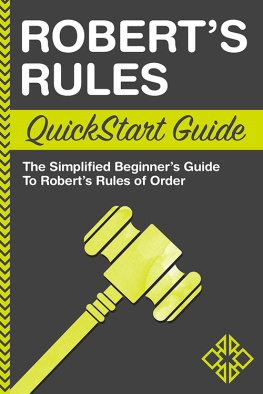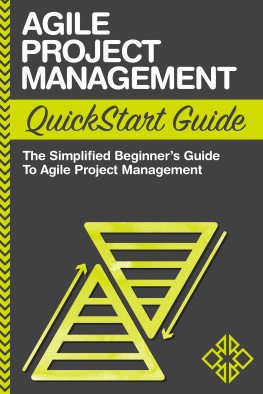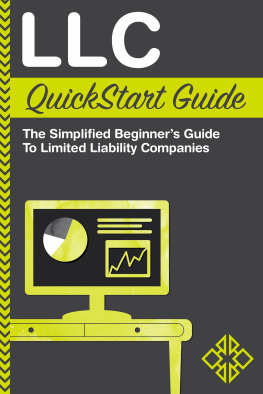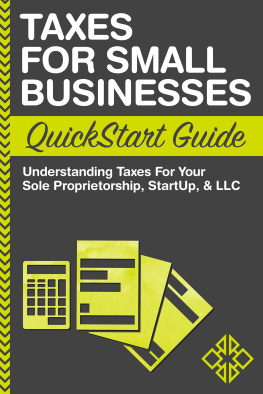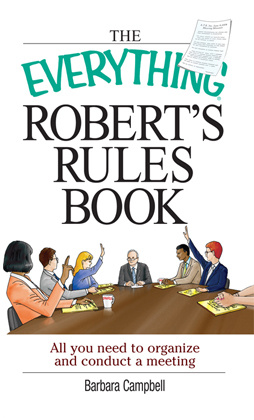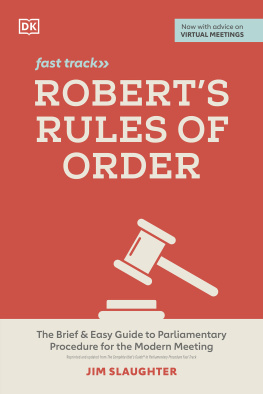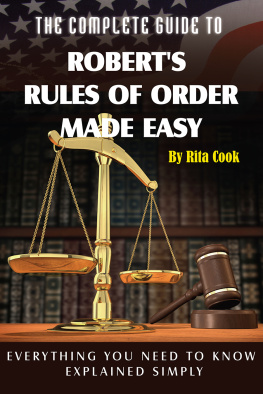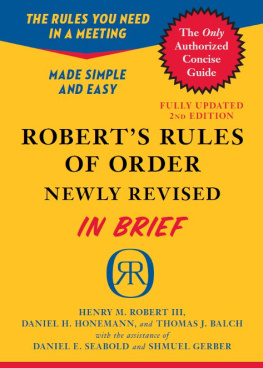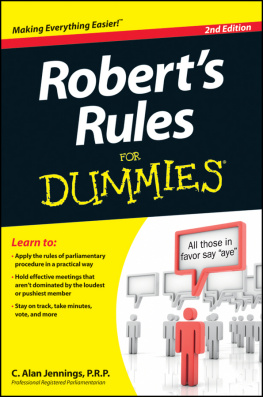Contents
Landmarks
Contents
Terms displayed in bold italic can be found defined in the glossary.

BEFORE YOU START READING,
DOWNLOAD YOUR FREE DIGITAL ASSETS!
Visit the URL below to access your free Digital Asset files that are included with the purchase of this book.

DOWNLOAD YOURS HERE:
www.clydebankmedia.com/roberts-assets
Introduction
Theres surely a reason that meetings are often synonymous with wasted time, frustration, annoyance, and dread. Consider this hypothesis: we are disillusioned with meetings because they should, in theory, be useful, vibrant, and enlightening, but too often, in practice, they prove anything but. Humans make the mistake of thinking that language development makes us different from animals. It really bums us out to find that, even with our complex brains and our capacity to verbally crystallize our ideas, we still find ourselves talking past one another, unable to listen and unable to effectively integrate our good ideas together into a whole greater than its parts.
The sad truth is that when too many big brains are in one room, theyre likely to suffer wasteful clashes of ego when they should be bursting at the seams with brilliant ideas. Ineffective meetings make us cynical. They ridicule our belief in teamwork and reinforce the unhealthy belief that we cant trust anyone but ourselves when it comes to getting stuff donetruly a toxic outlook in a cooperative work environment. Were disillusioned with meetings because they dangle the prospect of progress in our faces, before quickly exposing the pettiness and frailty of the human ego. Successful organizations and businesses dont thrive on cynicism, they suffer from it. So whats to be done?
US Army Colonel Henry Martyn Robert created the Roberts Rules of Order as a guidebook in the late 19th century. Its original title was Pocket Manual of Rules of Order for Deliberative Assemblies.
Note : Roberts Rules of Order is now in its 11th incarnation as of 2011, and its formal title is Roberts Rules of Order Newly Revised 11th Edition.
Colonel Roberts purpose was to derive an everyday methodology from formal parliamentary procedure. Since its inception, Roberts Rules of Order has become synonymous with formal parliamentary procedure. Be that as it may, the original pocket manualthough modeled after the rules used in the US House of Representativeswas intended for bodies much less formal. In fact, the impetus for the creation of Roberts Rules of Order was a public meeting held at the most humble of venues, a church.
Upon being asked to preside over this meeting, it occurred to Colonel Robertthen 26 years of age that he was at a complete loss for procedural know-how. Nonetheless, as legend has it, he tried to wing his way through the meeting much to his own chagrin and embarrassment. After enduring the humiliation of presiding over a civic body without experience, Colonel Robert vowed never again to return to such a post until hed taken the time to learn about parliamentary procedure.
Roberts autodidactic pursuit, however, would soon grow legs when he realized how badly a unified, written body of meeting procedure was needed. As a military man, the Colonel regularly toured various locales throughout the country and discovered that the guidelines followed during formal meetings varied tremendously from place to place. Vividly seeing the need for a standardized authority on a laymans parliamentary procedure, Colonel Robert penned his now famous work.
Note : The Colonel was no stranger to the pen. As an engineer, hed authored two other works of technical writing: The Water-Jet as an Aid to Engineering Construction (1881), and Analytical and Topical Index to the Reports of the Chief of Engineers and the Officers of the Corps of Engineers (compiled from 1866-1879 and published in 1881).
Roberts supposition was quickly validated. Ordinary societies needed a standard-bearing rule book to help govern their organizational detail and meetings. Upon publication, the book skyrocketed into public consciousness. Millions of copies were sold and distributed, and they continue to be to this day. Since its initial publication in 1876, Roberts Rules of Order has undergone two revisions and has been issued in a total of 11 editions. The most recent edition of the book, published in 2011, Roberts Rules of Order Newly Revised 11th Edition, includes a revision that accounts for modern phenomena that affect organizational behavior, such as the provisions for incorporating video and tele-conferencing into your formal meetings, as well as the role of email and other present-day practices.
This book focuses on interpreting and simplifying Roberts Rules of Order as they are set forth in the most recent, 2011 revision. In adherence to the original spirit of Roberts Rules, this book is intended to be used by ordinary societies as a practical utility for more productive (and shorter) meetings, to define a strong organizational structure, and to protect valuable minority voices that, without rules of order, are apt to be drowned out by the volume and bluster of the biggest ego in the room.
This book is the ideal companion for civic and professional groups, volunteer organizations, PTAs, home and property owners associations, motorcycle clubs and more. If youve got a bare bones grasp on parliamentary procure and want to fill in the blanks with useful details, then this book will help. This book will also prove a valuable resource if youve recently been appointed to a position of responsibility in your organization and youre looking to add professionalism, dignity, and efficiency to your group-level operations.
Note : Unlike the 19th century (and finely technical) language of our source text, this book articulates the practical application of Roberts Rules of Order in common language.
| 1 | Setting Up for Success
This chapter discusses how Roberts Rules guide the establishment of a new organization. Before you decide whether you need to read this chapter first or skip ahead, consider the following two factors:
- If youre participating in or presiding over a brand new organization, then this is a good place to start reading.
- If youre presiding over an organization with established but problematic or undisciplined procedure and you want to give your organization a fresh start, then this chapter is a good place to begin. Just be careful that you dont lose sight of the things your organization is doing correctly. As the townsfolk say, Even a broken clock is right twice a day. And, as the townsfolk have also been known to say Dont throw the baby out with the bath water.
Calling the 1 st Organizational Meeting
Youve identified a charitable cause, a political purpose, or some other reason to organize, and now youre ready to exercise your First Amendment right to assemble. Maybe youve had it up to your eyeballs with the way the state has neglected the local wildlife preserves, and youre ready to organize some civic opposition, or maybe youre concerned about a developer who wants to demolish a historically significant landmark and erect a new gaggle of gaudy condominiums. Maybe you already own your own gaudy condominium and are leading the way to establishing an active property owners association to protect the value of your collectivized dwelling structures. The point is this: your first organizational meeting, and all who attend it, should have a unified objective or purpose in mind.

